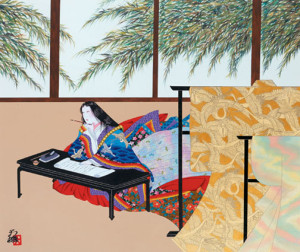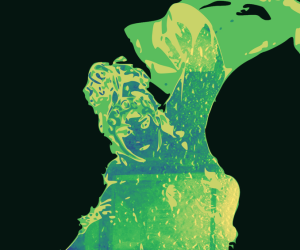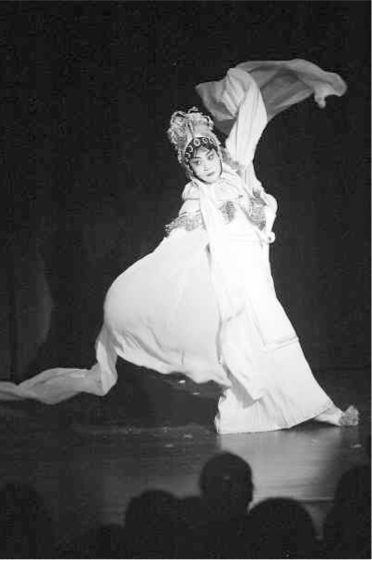A few weeks ago, Maura Cunningham wrote a fun post for GradHacker called “My Dissertation Sweater.” In it, she compared her experience writing a diss to knitting her first full sweater; although I don’t knit, I read it & nodded – both for the feelings about being a grad student in those final throes, as well as for the feelings evoked when I thought of the embroidery I do (and how it relates to my professional life). I also just finished an enormous (by my standards: 21″ x 10″ or thereabouts) embroidery project, which I’ve been working on in earnest between teaching, editing, writing, researching, and general living since July – something that’s made me reflect in general on Big Projects (like manuscripts – I’ve been throwing myself seriously into my first the past few months).
I’ve been cross stitching since I was 4. A great aunt taught me during the Thanksgiving holiday; I have the product of that first foray into needle, thread, and Aida cloth (it’s a Christmas ornament, a rocking horse with somewhat sloppy stitching – but, I was four!). I’ve drifted back to it over the years, going through periods where I finished (or almost finished) pretty big projects, periods where I would put a few hours of effort into something & then give it up, etc. I did some cool stuff in grad school – like a Ghost in the Shell: Stand Alone Complex OST album cover (this was given to a  then-SO), or a logo from Final Fantasy X (this still resides in my office). I wrote a how-to guide for Kotaku on charting & creating non-sprite cross stitch. When I got back from my research year in China, the sister of my significant other at the time was about to have a baby, and I wanted to embroider some kind of “birth announcement.” Now, if you have any familiarity with the types of kits available at your average craft store, they’re pretty sickly sweet (if you’re lucky, it’s a relatively non-saccharine version of Noah’s Ark. If you’re not, well …). So I started looking for something … interesting. Something that someone could conceivably hang on their wall at a much more advanced age & not be embarrassed of (e.g., not blocks, bears, or Noah’s Ark; something that perhaps had more intrinsic artistic value, at least as I defined it).
 And so I discovered the world of what I refer to as “high-end” cross stitch: patterns and fibers that are stocked at specialty shops, not your local chain craft store. This includes a pretty wide variety of patterns, from antique reproductions to super-modern patterns (I tend to gravitate more towards the “antique” side of things; perhaps this is lesson 1: historians often like old things); there are beautiful linens in addition to the more typical Aida cloth; fibers go way beyond plain cotton DMCs (I myself have a great love of hand dyed, over dyed cottons and silks, where one of the real draws is the often subtle variation in shade). It’s the one part of my life where I find myself consistently drawn to the high-end, the slow-made, the handmade, the produced-in-small-quantities. The one place I will consistently shell out for the luxury of something artisan crafted (a skein of mass produced DMC cotton thread generally runs about 30 cents; hand dyed cotton, $2 or more; silks – luscious and bouncy and just wonderful feeling, a real splurge! – $6 or $7). Well, that and artisan goat cheese.  But to set aside smart-ass commentary, spending a lot of time with needle & thread has taught me a lot about myself & the ways I prefer to work, as well as some of my deep-seated anxieties and concerns.
And so I discovered the world of what I refer to as “high-end” cross stitch: patterns and fibers that are stocked at specialty shops, not your local chain craft store. This includes a pretty wide variety of patterns, from antique reproductions to super-modern patterns (I tend to gravitate more towards the “antique” side of things; perhaps this is lesson 1: historians often like old things); there are beautiful linens in addition to the more typical Aida cloth; fibers go way beyond plain cotton DMCs (I myself have a great love of hand dyed, over dyed cottons and silks, where one of the real draws is the often subtle variation in shade). It’s the one part of my life where I find myself consistently drawn to the high-end, the slow-made, the handmade, the produced-in-small-quantities. The one place I will consistently shell out for the luxury of something artisan crafted (a skein of mass produced DMC cotton thread generally runs about 30 cents; hand dyed cotton, $2 or more; silks – luscious and bouncy and just wonderful feeling, a real splurge! – $6 or $7). Well, that and artisan goat cheese.  But to set aside smart-ass commentary, spending a lot of time with needle & thread has taught me a lot about myself & the ways I prefer to work, as well as some of my deep-seated anxieties and concerns.
Lesson 1: If you spend enough time with something, you’re going to constantly pick apart its flaws.Â
Every time I post pictures of my embroidery on Facebook or Twitter, friends invariably comment on how pretty it is! Meanwhile, I’m sitting at home going “OH MY GOD, I can’t believe I was so lazy that I let that stitch slip by … Doesn’t anyone notice that weird blending there? Why didn’t I rip out those flattened stitches? WHY did I leave this sitting in a frame for too long, I’ve ruined it.” When you spend a long period of time with your nose pressed up against something, you’re bound to notice its shortcomings and have a hard time viewing it objectively. Although I recognize this (with research, too: I’ve played the genuine cheerleader while a friend has commented negatively on their own work, seeing that they’re just too close to view it objectively), it’s hard to get over. I’m trying hard to get over it (as I am with all these things). I am (frankly) too lazy when it comes to embroidery – something I do for fun and relaxation – to fret too obsessively about it, but my perfectionist tendencies can really stymie getting good writing done, because I’m often afraid of making a mistake.
Lesson 1.5:Â Getting some distance is good, and will help you see past those flaws.
Cross stitch often looks a lot better from far away than it does close up. Is anyone going to see those slightly smushed stitches when this is hanging on my wall & they’re glancing at it? Probably not. A better example is my Final Fantasy X logo, where I tried the “blended thread” technique (using two different colored threads in one needle). As it turns out, I really (really) don’t like the effect, but it’s a lot more muted (and more harmonious) when viewed from a distance, and I’ve never had anyone look at it and go “My god, that’s hideous.” I suppose it’s possible they thought it, but more likely is: they saw it from a distance and thought it looked nice, because they haven’t spent a million hours mired in it. Even I – now that it’s been many years since I spent many hours mired in it – think it looks nice from a distance. The first six months after I defended my dissertation, I couldn’t open it without crying. I was ashamed of myself for producing such a half-baked, horrible piece of scholarship (and the typos! Oh my god, the typos). With some distance, I’ve managed to come around to seeing its good points and its flaws. I needed some time away from it before I could appreciate what I had done.
 Lesson 2: Getting from nothing to completed work often looks kind of ugly on the backend.
Lesson 2: Getting from nothing to completed work often looks kind of ugly on the backend.
There are some kinds of embroidery that are designed to be viewed from both sides equally. The “Holbein stitch” – so named because it appears in a lot of Tudor-era Holbein portraits – is one such stitch; it needed to be the same on both sides, since it shows up on collars and cuffs that didn’t just sit in one place. My embroidery, on the other hand, goes on a wall, or on an ornament, or on some other object that is going to be viewed from one side and that’s it. I try to keep things as neat as possible (carrying threads too far, or leaving excessively long tails of thread, or making knots does have an impact on the final impression from the front), but I could frankly care less whether or not it looks the same on the front as it does on the back. Some people can in fact do ultra-neat embroidery that could be displayed equally on the front or the back, but I am not one of those people. Likewise, I am not a perfect researcher or historian. I have bad habits. I am often a disaster in progress on the backend, and often feel perilously close to nervous breakdowns (friends who have been on the receiving end of one of my tear-filled ‘I am incompetent & I’m never going to be able to do this!‘ meltdowns can attest to this). But when it comes down to it, I get the job done, and get it done well (even if I do have to tell my students “Do not follow my example! Don’t do it! I’m telling you from experience!”). I’m always looking for ways to be a little “neater,” but it’s never going to be a totally smooth process and that’s OK.
Lesson 3:Â Mistakes happen. They’re not the end of the world, though they sure can seem like it.
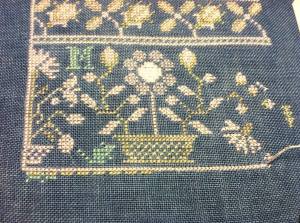 I’ve had to rip out an insane number of stitches in my years of stitching. It’s inevitable: you get motoring along, you stop counting as carefully as you should, and the next thing you know, you’re half a count off and the whole project is in danger of being off kilter. In embroidering on linen, I most often count over two, which means that mistakes are not always immediately apparent (part of the image at left is half a thread off: can you see where?). It is downright painful to spend hours ripping out many hours worth of stitching (as I did on the section shown), but sometimes you can fudge and redirect, sometimes you can’t. It’s usually not the end of the world. I suppose one of the nice things about being a historian is that often, when you run into a wall, it means a shift or redirect – not a “failure.” Kind of like figuring your way out of a half-thread mistake on a piece of linen. Sometimes it means a few hours of ripping out those stitches you so carefully put in … sometimes it means figuring out where you can shift a little here, shift a little there, and …
I’ve had to rip out an insane number of stitches in my years of stitching. It’s inevitable: you get motoring along, you stop counting as carefully as you should, and the next thing you know, you’re half a count off and the whole project is in danger of being off kilter. In embroidering on linen, I most often count over two, which means that mistakes are not always immediately apparent (part of the image at left is half a thread off: can you see where?). It is downright painful to spend hours ripping out many hours worth of stitching (as I did on the section shown), but sometimes you can fudge and redirect, sometimes you can’t. It’s usually not the end of the world. I suppose one of the nice things about being a historian is that often, when you run into a wall, it means a shift or redirect – not a “failure.” Kind of like figuring your way out of a half-thread mistake on a piece of linen. Sometimes it means a few hours of ripping out those stitches you so carefully put in … sometimes it means figuring out where you can shift a little here, shift a little there, and …
Lesson 4:Â Things sometimes look stitched together to you, but it’s often not that noticeable … and just part of the process.
 The latest piece I finished was a band sampler – different horizontal bands put together vertically. In retrospect, the smart way to do this would have been to embroider each horizontal band, moving down the sampler. I didn’t do this for a variety of reasons. This means that there’s a pretty clear dividing line running through the middle of my project … or is there? I mean, it’s definitely there, but going to point 1, I’m not sure how many people would really notice (some time with an iron also seems to help this). I’ve read academic work and been able to see the “seams,” but most often, the author needs to note those for me. And when it comes down to it, few projects just spring fully formed from someone’s head – particularly a first project, often based on one’s dissertation and article(s). The author (you) is going to notice the Frankenstein aspects of how everything fits together, but the average viewer isn’t going to see those seams – or at least not to the degree that you do. And pulling things together is just part of the process.
The latest piece I finished was a band sampler – different horizontal bands put together vertically. In retrospect, the smart way to do this would have been to embroider each horizontal band, moving down the sampler. I didn’t do this for a variety of reasons. This means that there’s a pretty clear dividing line running through the middle of my project … or is there? I mean, it’s definitely there, but going to point 1, I’m not sure how many people would really notice (some time with an iron also seems to help this). I’ve read academic work and been able to see the “seams,” but most often, the author needs to note those for me. And when it comes down to it, few projects just spring fully formed from someone’s head – particularly a first project, often based on one’s dissertation and article(s). The author (you) is going to notice the Frankenstein aspects of how everything fits together, but the average viewer isn’t going to see those seams – or at least not to the degree that you do. And pulling things together is just part of the process.
Lesson 5:Â Your stash can be the best motivation to get through something.
I have a giant stack of projects I’ve stashed in anticipation of getting to them … someday. I sort through them occasionally just to give myself an idea of what comes next (and to stop myself from adding to the stash). But really, one of the biggest motivators in getting through a piece in progress is the idea of starting something new – something that’s really exciting, and has caught my attention! While I guess it would be great to take all the time in the world to see my dissertation through to its (hopeful) conclusion, I have things in my academic stash – projects I’m incredibly enthused about, but can’t get started on until this one is done.
Lesson 6:Â Appreciate the fact that there are wondrous things that only you are going to notice.
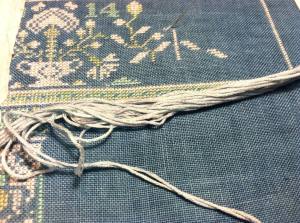 I ran out of a dye lot of thread halfway through the project. As it turned out, the new dye lot (of the same “color” thread) had the most glorious shade of lavender in it: I mean, really spectacular. I spent a long time just looking at the thread when I started using it (even though it didn’t “match” exactly – going back to point 4). I tried to photograph it and failed (though you can probably see a little of the variation). I loved the way the pale blue ran into darker blue then into pale purple – just exquisite. I was thrilled with the way it stitched up, and thought it added a nice pop to the project. It’s something I think most people wouldn’t even notice. But I know it’s there, and I take delight in that subtle shade shift. In much the same way, everyone’s work is sprinkled with things they – experts on whatever it is they are writing on – are going to notice, and the rest of us won’t. Friends often query after I read a draft: “Oh, did you think such-and-such part was funny? What about this? Did you notice that turn of phrase? Did you like it?” I usually answer: “Ah … no? I didn’t notice? Was I supposed to? I’m not saying it’s not clever, just that it flew right by …” Most of the time, I’m just not in on the joke, because I’m not the one that has spent a billion hours with the sources and subjects. In much the same way, I still take an unholy amount of pleasure in some of the stories I relate (“Isn’t this spat between high level Marxist intellectuals over this minor point of historical materialism as applied to the Cowherd and the Weaving Girl just HILARIOUS?”), and I just have to come to terms with the fact that they make me smile (because I’m the one that’s been wallowing in them for a period of years), and that’s enough.
I ran out of a dye lot of thread halfway through the project. As it turned out, the new dye lot (of the same “color” thread) had the most glorious shade of lavender in it: I mean, really spectacular. I spent a long time just looking at the thread when I started using it (even though it didn’t “match” exactly – going back to point 4). I tried to photograph it and failed (though you can probably see a little of the variation). I loved the way the pale blue ran into darker blue then into pale purple – just exquisite. I was thrilled with the way it stitched up, and thought it added a nice pop to the project. It’s something I think most people wouldn’t even notice. But I know it’s there, and I take delight in that subtle shade shift. In much the same way, everyone’s work is sprinkled with things they – experts on whatever it is they are writing on – are going to notice, and the rest of us won’t. Friends often query after I read a draft: “Oh, did you think such-and-such part was funny? What about this? Did you notice that turn of phrase? Did you like it?” I usually answer: “Ah … no? I didn’t notice? Was I supposed to? I’m not saying it’s not clever, just that it flew right by …” Most of the time, I’m just not in on the joke, because I’m not the one that has spent a billion hours with the sources and subjects. In much the same way, I still take an unholy amount of pleasure in some of the stories I relate (“Isn’t this spat between high level Marxist intellectuals over this minor point of historical materialism as applied to the Cowherd and the Weaving Girl just HILARIOUS?”), and I just have to come to terms with the fact that they make me smile (because I’m the one that’s been wallowing in them for a period of years), and that’s enough.
Lesson 7:Â Take pleasure in the mundane joys of work.
Cross stitching is fundamentally pretty boring work. By which I mean: it’s repetitive. I have a pattern. I have one stitch. It is not thrilling from the perspective of changing from moment to moment. There are color changes … and the patterns can be complicated … but it’s not some crazy exciting process. And yet I take great joy in it on a number of levels. It’s productive (you can see progress!). It’s pretty. It’s soothing. It’s comfortable, and something I enjoy. Research, to me, is much the same: sometimes it’s wildly exciting, often it’s not, and sometimes it can be one hell of a horrible slog. But there’s something comfortable about it, and it is something I really enjoy (even when I’m grinding my teeth in anticipation of the end). As I’ve dug into my manuscript, I’ve found myself reminded that I do enjoy the mundane process of nosing around sources (not even things holding exciting finds: just filling in holes here and there), and I especially enjoy writing. It’s a terrifying process, but also one that reminds me of why I’m doing it in the first place – I enjoy this. I’m good at this. For all the inevitable flaws, I’ll be able to do this. It’s just a matter of transferring some of those lessons from needle and thread to dictionary and word processor.
I often feel oddly bereft after finishing large projects, be they embroidery, research, or editing - what do I do now? I like keeping projects around for a little while after finishing, so I can take a peek back and look at all the hard work I’ve done, before moving on to something else. I’ll be taking this latest piece down to the framer’s next week, but until then, I’ll keep it in a safe place to look at and touch now and again. I’m a very tactile person, though it’s not something I often get to indulge in with my research. But there’s something about running my fingers over the surface of an embroidered piece (even though you’re not supposed to; skin oils are bad for fibers!) – it’s a nice sensation, something I can’t quite describe – or feeling the peculiar weight of the fabric once a large design is mostly or entirely stitched onto its surface. It’s a wonderful, heavy feeling – the weight of progress, I guess.




